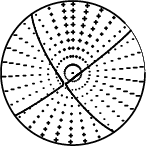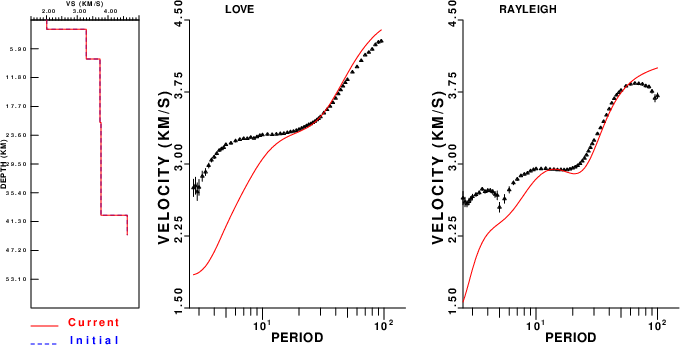Location
Location ANSS
The ANSS event ID is usp000jadn and the event page is at
https://earthquake.usgs.gov/earthquakes/eventpage/usp000jadn/executive.
2011/11/06 03:53:10 35.532 -96.765 5.2 5.7 Oklahoma
Focal Mechanism
USGS/SLU Moment Tensor Solution
ENS 2011/11/06 03:53:10:0 35.53 -96.76 5.2 5.7 Oklahoma
Stations used:
AG.CCAR AG.FCAR AG.HHAR AG.LCAR AG.WHAR AG.WLAR IU.CCM
NM.HBAR NM.MGMO NM.PBMO NM.UALR TA.136A TA.137A TA.236A
TA.237A TA.238A TA.ABTX TA.N33A TA.N34A TA.O33A TA.O34A
TA.O35A TA.O36A TA.O37A TA.O38A TA.P34A TA.P35A TA.P36A
TA.P37A TA.P38A TA.P39B TA.Q34A TA.Q35A TA.Q36A TA.Q37A
TA.Q38A TA.Q39A TA.Q40A TA.R34A TA.R35A TA.R36A TA.R37A
TA.R38A TA.R39A TA.R40A TA.R41A TA.S34A TA.S35A TA.S36A
TA.S37A TA.S38A TA.S39A TA.S40A TA.S42A TA.T34A TA.T35A
TA.T36A TA.T37A TA.T38A TA.T39A TA.T40A TA.T41A TA.TUL1
TA.U32A TA.U35A TA.U36A TA.U37A TA.U38A TA.U39A TA.U40A
TA.U41A TA.U42A TA.U43A TA.V35A TA.V36A TA.V37A TA.V38A
TA.V39A TA.V40A TA.V41A TA.V42A TA.V43A TA.W35A TA.W36A
TA.W37B TA.W38A TA.W39A TA.W40A TA.W41B TA.W42A TA.W43A
TA.WHTX TA.X35A TA.X36A TA.X37A TA.X38A TA.X39A TA.X40A
TA.X41A TA.X42A TA.X43A TA.Y35A TA.Y36A TA.Y37A TA.Y38A
TA.Y39A TA.Y40A TA.Y41A TA.Y42A TA.Z37A TA.Z38A TA.Z40A
US.KSU1 US.MIAR US.WMOK
Filtering commands used:
hp c 0.01 n 3
lp c 0.06 n 3
Best Fitting Double Couple
Mo = 3.05e+24 dyne-cm
Mw = 5.59
Z = 8 km
Plane Strike Dip Rake
NP1 235 85 -175
NP2 145 85 -5
Principal Axes:
Axis Value Plunge Azimuth
T 3.05e+24 0 10
N 0.00e+00 83 280
P -3.05e+24 7 100
Moment Tensor: (dyne-cm)
Component Value
Mxx 2.86e+24
Mxy 1.06e+24
Mxz 6.69e+22
Myy -2.82e+24
Myz -3.67e+23
Mzz -4.62e+22
######### T ##
############# ######
---#########################
-----#########################
--------##########################
----------######################----
------------##################--------
--------------##############------------
---------------##########---------------
------------------#####-------------------
-------------------#----------------------
-----------------###-------------------
---------------######------------------ P
-----------###########----------------
---------##############-----------------
------##################--------------
---#####################------------
########################----------
########################------
#########################---
######################
##############
Global CMT Convention Moment Tensor:
R T P
-4.62e+22 6.69e+22 3.67e+23
6.69e+22 2.86e+24 -1.06e+24
3.67e+23 -1.06e+24 -2.82e+24
Details of the solution is found at
http://www.eas.slu.edu/eqc/eqc_mt/MECH.NA/20111106035310/index.html
|
Preferred Solution
The preferred solution from an analysis of the surface-wave spectral amplitude radiation pattern, waveform inversion or first motion observations is
STK = 145
DIP = 85
RAKE = -5
MW = 5.59
HS = 8.0
The NDK file is 20111106035310.ndk
The waveform inversion is preferred.
Moment Tensor Comparison
The following compares this source inversion to those provided by others. The purpose is to look for major differences and also to note slight differences that might be inherent to the processing procedure. For completeness the USGS/SLU solution is repeated from above.
| SLU |
USGSMT |
GCMT |
USGS/SLU Moment Tensor Solution
ENS 2011/11/06 03:53:10:0 35.53 -96.76 5.2 5.7 Oklahoma
Stations used:
AG.CCAR AG.FCAR AG.HHAR AG.LCAR AG.WHAR AG.WLAR IU.CCM
NM.HBAR NM.MGMO NM.PBMO NM.UALR TA.136A TA.137A TA.236A
TA.237A TA.238A TA.ABTX TA.N33A TA.N34A TA.O33A TA.O34A
TA.O35A TA.O36A TA.O37A TA.O38A TA.P34A TA.P35A TA.P36A
TA.P37A TA.P38A TA.P39B TA.Q34A TA.Q35A TA.Q36A TA.Q37A
TA.Q38A TA.Q39A TA.Q40A TA.R34A TA.R35A TA.R36A TA.R37A
TA.R38A TA.R39A TA.R40A TA.R41A TA.S34A TA.S35A TA.S36A
TA.S37A TA.S38A TA.S39A TA.S40A TA.S42A TA.T34A TA.T35A
TA.T36A TA.T37A TA.T38A TA.T39A TA.T40A TA.T41A TA.TUL1
TA.U32A TA.U35A TA.U36A TA.U37A TA.U38A TA.U39A TA.U40A
TA.U41A TA.U42A TA.U43A TA.V35A TA.V36A TA.V37A TA.V38A
TA.V39A TA.V40A TA.V41A TA.V42A TA.V43A TA.W35A TA.W36A
TA.W37B TA.W38A TA.W39A TA.W40A TA.W41B TA.W42A TA.W43A
TA.WHTX TA.X35A TA.X36A TA.X37A TA.X38A TA.X39A TA.X40A
TA.X41A TA.X42A TA.X43A TA.Y35A TA.Y36A TA.Y37A TA.Y38A
TA.Y39A TA.Y40A TA.Y41A TA.Y42A TA.Z37A TA.Z38A TA.Z40A
US.KSU1 US.MIAR US.WMOK
Filtering commands used:
hp c 0.01 n 3
lp c 0.06 n 3
Best Fitting Double Couple
Mo = 3.05e+24 dyne-cm
Mw = 5.59
Z = 8 km
Plane Strike Dip Rake
NP1 235 85 -175
NP2 145 85 -5
Principal Axes:
Axis Value Plunge Azimuth
T 3.05e+24 0 10
N 0.00e+00 83 280
P -3.05e+24 7 100
Moment Tensor: (dyne-cm)
Component Value
Mxx 2.86e+24
Mxy 1.06e+24
Mxz 6.69e+22
Myy -2.82e+24
Myz -3.67e+23
Mzz -4.62e+22
######### T ##
############# ######
---#########################
-----#########################
--------##########################
----------######################----
------------##################--------
--------------##############------------
---------------##########---------------
------------------#####-------------------
-------------------#----------------------
-----------------###-------------------
---------------######------------------ P
-----------###########----------------
---------##############-----------------
------##################--------------
---#####################------------
########################----------
########################------
#########################---
######################
##############
Global CMT Convention Moment Tensor:
R T P
-4.62e+22 6.69e+22 3.67e+23
6.69e+22 2.86e+24 -1.06e+24
3.67e+23 -1.06e+24 -2.82e+24
Details of the solution is found at
http://www.eas.slu.edu/eqc/eqc_mt/MECH.NA/20111106035310/index.html
|
USGS/SLU Regional Moment Solution
OKLAHOMA
11/11/06 03:53:10.53
Epicenter: 35.537 -96.747
MW 5.6
USGS/SLU REGIONAL MOMENT TENSOR
Depth 7 No. of sta: 32
Moment Tensor; Scale 10**17 Nm
Mrr=-0.17 Mtt= 3.22
Mpp=-3.05 Mrt=-0.07
Mrp=-0.28 Mtp=-1.09
Principal axes:
T Val= 3.40 Plg= 0 Azm=190
N -0.14 85 95
P -3.26 5 280
Best Double Couple:Mo=3.3*10**17
NP1:Strike= 55 Dip=87 Slip=-176
NP2: 324 86 -3

|
November 6, 2011, OKLAHOMA, MW=5.7
Meredith Nettles
Goran Ekstrom
CENTROID-MOMENT-TENSOR SOLUTION
GCMT EVENT: C201111060353A
DATA: II IU DK CU MN G IC GE LD
L.P.BODY WAVES:108S, 197C, T= 40
MANTLE WAVES: 67S, 77C, T=125
SURFACE WAVES: 146S, 319C, T= 50
TIMESTAMP: Q-20111106092416
CENTROID LOCATION:
ORIGIN TIME: 03:53:13.4 0.1
LAT:35.64N 0.01;LON: 96.73W 0.01
DEP: 12.1 0.6;TRIANG HDUR: 1.8
MOMENT TENSOR: SCALE 10**24 D-CM
RR=-0.360 0.035; TT= 4.580 0.041
PP=-4.220 0.042; RT=-1.550 0.133
RP=-0.320 0.095; TP=-1.640 0.034
PRINCIPAL AXES:
1.(T) VAL= 5.262;PLG=15;AZM=189
2.(N) -0.659; 73; 40
3.(P) -4.602; 8; 282
BEST DBLE.COUPLE:M0= 4.93*10**24
NP1: STRIKE=326;DIP=74;SLIP= 5
NP2: STRIKE=235;DIP=86;SLIP= 164
###########
###################
-----##################
---------##################
------------##############---
---------------#########-------
--------------#####----------
P ------------------------------
-------------####-------------
--------------#######------------
-----------###########-----------
--------##############---------
------#################--------
--####################-------
######################-----
######## #########---
###### T ##########
## ######
|
Magnitudes
Given the availability of digital waveforms for determination of the moment tensor, this section documents the added processing leading to mLg, if appropriate to the region, and ML by application of the respective IASPEI formulae. As a research study, the linear distance term of the IASPEI formula
for ML is adjusted to remove a linear distance trend in residuals to give a regionally defined ML. The defined ML uses horizontal component recordings, but the same procedure is applied to the vertical components since there may be some interest in vertical component ground motions. Residual plots versus distance may indicate interesting features of ground motion scaling in some distance ranges. A residual plot of the regionalized magnitude is given as a function of distance and azimuth, since data sets may transcend different wave propagation provinces.
mLg Magnitude

Left: mLg computed using the IASPEI formula. Center: mLg residuals versus epicentral distance ; the values used for the trimmed mean magnitude estimate are indicated.
Right: residuals as a function of distance and azimuth.
ML Magnitude

Left: ML computed using the IASPEI formula for Horizontal components. Center: ML residuals computed using a modified IASPEI formula that accounts for path specific attenuation; the values used for the trimmed mean are indicated. The ML relation used for each figure is given at the bottom of each plot.
Right: Residuals from new relation as a function of distance and azimuth.

Left: ML computed using the IASPEI formula for Vertical components (research). Center: ML residuals computed using a modified IASPEI formula that accounts for path specific attenuation; the values used for the trimmed mean are indicated. The ML relation used for each figure is given at the bottom of each plot.
Right: Residuals from new relation as a function of distance and azimuth.
Context
The left panel of the next figure presents the focal mechanism for this earthquake (red) in the context of other nearby events (blue) in the SLU Moment Tensor Catalog. The right panel shows the inferred direction of maximum compressive stress and the type of faulting (green is strike-slip, red is normal, blue is thrust; oblique is shown by a combination of colors). Thus context plot is useful for assessing the appropriateness of the moment tensor of this event.
Waveform Inversion using wvfgrd96
The focal mechanism was determined using broadband seismic waveforms. The location of the event (star) and the
stations used for (red) the waveform inversion are shown in the next figure.

|
|
Location of broadband stations used for waveform inversion
|
The program wvfgrd96 was used with good traces observed at short distance to determine the focal mechanism, depth and seismic moment. This technique requires a high quality signal and well determined velocity model for the Green's functions. To the extent that these are the quality data, this type of mechanism should be preferred over the radiation pattern technique which requires the separate step of defining the pressure and tension quadrants and the correct strike.
The observed and predicted traces are filtered using the following gsac commands:
hp c 0.01 n 3
lp c 0.06 n 3
The results of this grid search are as follow:
DEPTH STK DIP RAKE MW FIT
WVFGRD96 0.5 325 85 -10 5.26 0.3693
WVFGRD96 1.0 325 85 -5 5.29 0.4045
WVFGRD96 2.0 325 85 -5 5.40 0.5247
WVFGRD96 3.0 325 90 0 5.45 0.5795
WVFGRD96 4.0 145 90 0 5.49 0.6132
WVFGRD96 5.0 145 90 0 5.51 0.6285
WVFGRD96 6.0 325 90 5 5.54 0.6352
WVFGRD96 7.0 145 85 -5 5.56 0.6400
WVFGRD96 8.0 145 85 -5 5.59 0.6425
WVFGRD96 9.0 145 85 -10 5.60 0.6298
WVFGRD96 10.0 145 90 -15 5.61 0.6187
WVFGRD96 11.0 325 90 15 5.62 0.6105
WVFGRD96 12.0 325 85 15 5.63 0.6055
WVFGRD96 13.0 325 85 15 5.64 0.6013
WVFGRD96 14.0 325 85 15 5.65 0.5960
WVFGRD96 15.0 325 80 10 5.66 0.5919
WVFGRD96 16.0 325 80 10 5.66 0.5870
WVFGRD96 17.0 325 80 10 5.67 0.5821
WVFGRD96 18.0 325 80 10 5.68 0.5778
WVFGRD96 19.0 325 80 10 5.68 0.5689
WVFGRD96 20.0 325 80 10 5.69 0.5632
WVFGRD96 21.0 325 80 10 5.70 0.5572
WVFGRD96 22.0 325 80 10 5.71 0.5482
WVFGRD96 23.0 325 80 10 5.71 0.5405
WVFGRD96 24.0 325 80 10 5.72 0.5326
WVFGRD96 25.0 325 80 10 5.72 0.5241
WVFGRD96 26.0 325 80 10 5.73 0.5144
WVFGRD96 27.0 325 80 10 5.73 0.5044
WVFGRD96 28.0 325 80 10 5.74 0.4941
WVFGRD96 29.0 325 80 10 5.75 0.4857
The best solution is
WVFGRD96 8.0 145 85 -5 5.59 0.6425
The mechanism corresponding to the best fit is

|
|
Figure 1. Waveform inversion focal mechanism
|
The best fit as a function of depth is given in the following figure:

|
|
Figure 2. Depth sensitivity for waveform mechanism
|
The comparison of the observed and predicted waveforms is given in the next figure. The red traces are the observed and the blue are the predicted.
Each observed-predicted component is plotted to the same scale and peak amplitudes are indicated by the numbers to the left of each trace. A pair of numbers is given in black at the right of each predicted traces. The upper number it the time shift required for maximum correlation between the observed and predicted traces. This time shift is required because the synthetics are not computed at exactly the same distance as the observed, the velocity model used in the predictions may not be perfect and the epicentral parameters may be be off.
A positive time shift indicates that the prediction is too fast and should be delayed to match the observed trace (shift to the right in this figure). A negative value indicates that the prediction is too slow. The lower number gives the percentage of variance reduction to characterize the individual goodness of fit (100% indicates a perfect fit).
The bandpass filter used in the processing and for the display was
hp c 0.01 n 3
lp c 0.06 n 3

|
|
Figure 3. Waveform comparison for selected depth. Red: observed; Blue - predicted. The time shift with respect to the model prediction is indicated. The percent of fit is also indicated. The time scale is relative to the first trace sample.
|

|
|
Focal mechanism sensitivity at the preferred depth. The red color indicates a very good fit to the waveforms.
Each solution is plotted as a vector at a given value of strike and dip with the angle of the vector representing the rake angle, measured, with respect to the upward vertical (N) in the figure.
|
A check on the assumed source location is possible by looking at the time shifts between the observed and predicted traces. The time shifts for waveform matching arise for several reasons:
- The origin time and epicentral distance are incorrect
- The velocity model used for the inversion is incorrect
- The velocity model used to define the P-arrival time is not the
same as the velocity model used for the waveform inversion
(assuming that the initial trace alignment is based on the
P arrival time)
Assuming only a mislocation, the time shifts are fit to a functional form:
Time_shift = A + B cos Azimuth + C Sin Azimuth
The time shifts for this inversion lead to the next figure:

The derived shift in origin time and epicentral coordinates are given at the bottom of the figure.
Surface-Wave Focal Mechanism
The following figure shows the stations used in the grid search for the best focal mechanism to fit the surface-wave spectral amplitudes of the Love and Rayleigh waves.
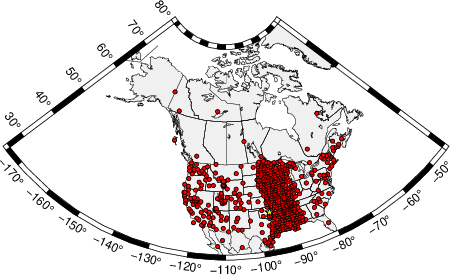
|
|
Location of broadband stations used to obtain focal mechanism from surface-wave spectral amplitudes
|
The surface-wave determined focal mechanism is shown here.
NODAL PLANES
STK= 53.70
DIP= 85.17
RAKE= 164.95
OR
STK= 144.99
DIP= 75.00
RAKE= 5.00
DEPTH = 9.0 km
Mw = 5.76
Best Fit 0.7820 - P-T axis plot gives solutions with FIT greater than FIT90
Surface-wave analysis
Surface wave analysis was performed using codes from
Computer Programs in Seismology, specifically the
multiple filter analysis program do_mft and the surface-wave
radiation pattern search program srfgrd96.
Data preparation
Digital data were collected, instrument response removed and traces converted
to Z, R an T components. Multiple filter analysis was applied to the Z and T traces to obtain the Rayleigh- and Love-wave spectral amplitudes, respectively.
These were input to the search program which examined all depths between 1 and 25 km
and all possible mechanisms.

|
|
Best mechanism fit as a function of depth. The preferred depth is given above. Lower hemisphere projection
|
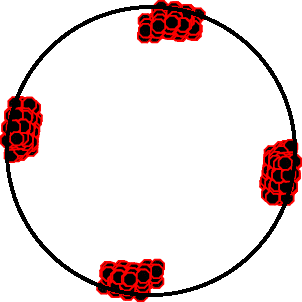
|
|
Pressure-tension axis trends. Since the surface-wave spectra search does not distinguish between P and T axes and since there is a 180 ambiguity in strike, all possible P and T axes are plotted. First motion data and waveforms will be used to select the preferred mechanism. The purpose of this plot is to provide an idea of the
possible range of solutions. The P and T-axes for all mechanisms with goodness of fit greater than 0.9 FITMAX (above) are plotted here.
|
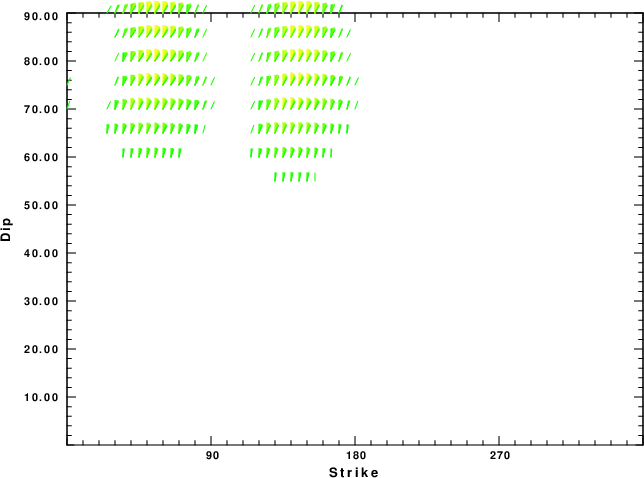
|
|
Focal mechanism sensitivity at the preferred depth. The red color indicates a very good fit to the Love and Rayleigh wave radiation patterns.
Each solution is plotted as a vector at a given value of strike and dip with the angle of the vector representing the rake angle, measured, with respect to the upward vertical (N) in the figure. Because of the symmetry of the spectral amplitude rediation patterns, only strikes from 0-180 degrees are sampled.
|
Love-wave radiation patterns
Rayleigh-wave radiation patterns












